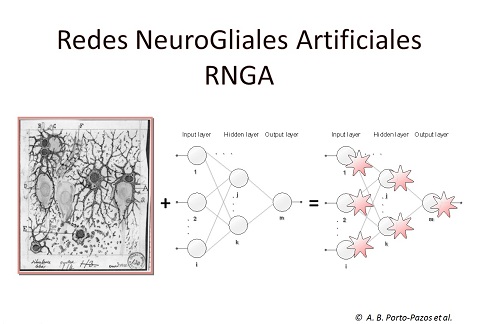ACADEMIA
New research in AI systems supported by CESGA
UDC research, demonstrated for the first time with CESGA support, has created the so-called artificial neuron-glia networks (NGN)
Get the advanced artificial intelligence systems that simulate the behavior of neurons learn things for themselves and even extend our knowledge of the time of the information processing system of the brain are two of the objectives of the research team at the Department of Technology Information and Communication of the University of A Coruña (UDC) led by Professor Ana Belen Porto Pazos and who works with the support of the computing power of the Supercomputing Center of Galicia (CESGA).
This small team that is within the research group led by Professor Alejandro Pazos, develops "a multidisciplinary research at the crossroads of research in connected branch of artificial intelligence (AI) research in the area of functional neurobiology and systems neuroscience, to try to encourage the processing of information in computers and increase knowledge about how information is processed in glial brain circuits," explains the researcher. Glial cells (also known generically as glia or neuroglia) are feeder cells of the nervous system that play the main supporting function of the neurons, are active also in the brain processing of information in the body.
The computational modeling of "sistemas conexionistas" (SC) that simulate the activity of organized groups of neurons can solve real world problems using natural knowledge may be uncertain, imprecise, inconsistent and incomplete, in which the construction of a conventional computer program or branch symbolic AI to cover all possibilities would be very difficult or even unthinkable.
artificial neuron-glia networks (NGN)
Sistemas conexionistas (SC) do not require the task to run as scheduled, but they are able to learn from experience, examples and then generalize, adapting to the different circumstances of the task to be addressed as the human brain does. The professor emphasizes that "recent discoveries in the field of neuroscience on the important role of astrocytes glial system in processing information, contrary to what was thought, showed that these cells are crucial when performing cognitive tasks."
The research team led by "failed to show for the first time through the use of CESGA gear the multilayer sistemas conexionistas including new artificial elements that try to simulate astrocytes increases the effectiveness of these systems in problem solving when artificial astrocytes induce potentiation at synapses," which led to create so-called artificial neuron-glia networks (NGN). The NGN are systems that incorporate connection addition of artificial neurons, control elements which simulate the behavior of brain astrocytes (Glial cell system).
Ana Belen Porto explained that "yet we do not known exactly how the interaction and communication neuron-astrocyte and astrocyte-astrocyte in the brain and what kind of effect produced by astrocytes at synapses according to neuronal activity, so it is crucial to continue the investigation. Based on previous results of the team and through collaboration with neuroscientists Navarrete Marta Alfonso Araque and Institute of Neurobiology Ramón y Cajal, CSIC, this research aims to help understand this key interaction and communication by performing the necessary testing from the standpoint of artificial intelligence and apply the behavior glimpsed by neuroscientists to effectively tackling real problems."
This research is very new, he notes, and a subject of investigation that is "very novel connectionist models of this type, which also serve for basic research on the brain to solve real problems, never designed to date. Research into these systems in artificial intelligence has a direct application to problems of initial classification, prediction and pattern recognition and will focus on solving real problems in the biomedical field. In addition, experimentation with these computer models more similar to the brain, give them ideas neuroscientists may be very beneficial by increasing knowledge about brain glial circuits."
The team that Ana Belen Porto Pazos is also principal investigator is formed by researchers and collaborators Veiguela Noha, Alberto Alvarellos, Paul Mesejo and Oscar Ibanez.

